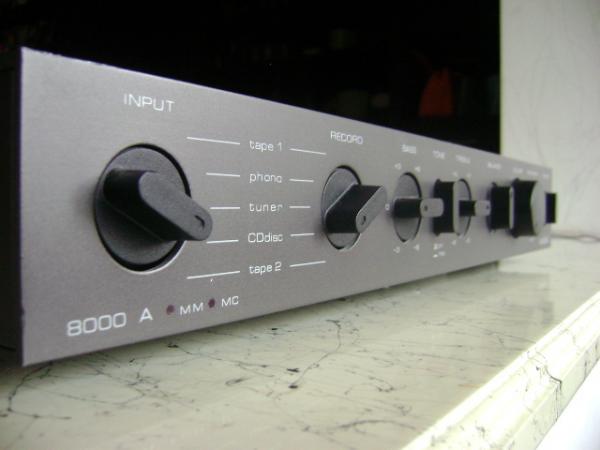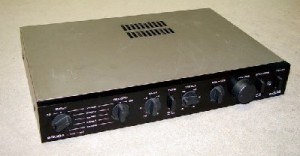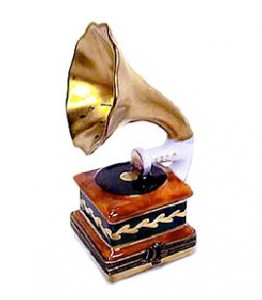The Audiolab 8000A integrated amplifier is an old friend. I have listened to this amplifier for the better part of fifteen years. To me, it feels like coming home.
It is a full functioning, integrated amplifier (including a MC and MM phono stage). Well-built chassis-terrible sheet metal. The front panel is well built and simplicity itself. All controls are well laid out, have a reasonable feel to them and are easy to discern. Finished in a dark grey, it is handsome in the utilitarian sense of the word. No, Tag McLaren made the electronics high style, but the basic Audiolab is not ugly. Typically British with cheesy, sheet metal. Knock on the top or sides and it rattles like a 30-year-old Datsun 510 (I owned one of these great cars too. I got rid of it because, at that time, I was a young idiot—I simply didn’t appreciate what I had). No engineering degree or the ability to contort one’s body is required to operate it.
Audiolab 8000A Review
Connections are RCA connectors for all inputs including 2 phono inputs (one for MC and another for MM cartridges). The amp has a push-in switch to set which phono stage is being used. Two sets of small binding post suitable for spades or push in style banana connectors take care of the speaker connection facilities . They also accept bare wire. Also present is an IEC AC input socket, allowing you to change to the AC cable of your choice. The stock cable is of good quality.
This amp was owned by me and sold last year to finance my McCormack purchase. I had modified it per instructions from Artech (formerly the North American distributor) to separate the power and pre-amp sections and used a short pair of Audioquest Ruby interconnects to join the pre-amp out to power amp section, or used a passive pre-amp with Alps “blue” attenuator. It is in this incarnation that the old amp remains.
Rated at 50 or 60 watts per channel (depends on the magazine or year). It is capable of good drive on most woofers and therefore has the impression of muscularity. Sometimes criticised for being polite, it (this early example) can be particularly revealing. Intolerable of poor sources (or any with a rising top end), it sings with the right stuff.
Listening tests were conducted in “the lair”, a 19′ X 12′ (with an 8’X8′ bump out on the back wall) basement room with concrete floors and 1970’s old school “panelling”. The floor is carpeted with thin pile orange and brown carpet, and has a wood/mirror ceiling. The end of the room opens up via 3 brick arches into another 10′ X 25′ opening. Loudspeakers that were used: JE Labs baffles with Oxford J12s fullrangers (and Seas tweeters) and the cheap and cheerful Athena AS-B1 bookshelfs. Both were connected to the amp via Cat 5 cable. Sources used were the Sony CDP 990, the modded Sony Playstation, and the Oracle Alex/SME 309/ Grado Sig 8.. Music picked for use were my “standards”… Mary Black’s “the collection” (Grapevine GRACD 010), John Lee Hooker’s “The Best of Friends”(pointblank 7243 8 48424 26), Naim’s Hi-Fi Collection 2(HFC259-10-04, a free cd w/Hi-FI Choice , Oct o4), James Taylor Greatest Hits (Warner Brothers, lp version BS2979), Mozart Requiem KV 626, William Christie and Les Arts Florissants (Erato630-10697-2 ) and John Williams and the Boston Pops “Out of this World” (Philips 411 185-2 –the cd version number. I misplaced my record before quoting it here :-().
I first tried the Audiolab with the Sony CDP 990 and the open baffles. Regardless of which music I put on, there was always an aggressive quality to the sound to the sound. Interconnects were the Audioquest Rubys as per usual, and are not a “zippy” cable by any stretch. The music had everything one would expect … appropriate sound stage height and width, but an irritating top end that stayed with all selections played. I then tried it with a Marantz CD5000 that was here at the house for a little while. Much better! Substituting out the Marantz for the Playstation, better yet again. Don’t be fooled, Sony had one hell of a cd player in the PSX (original). A few minor mods improves it immensely. It was in this incarnation of the system that I completed my listening, and where my caveats come from. Please put a source that is extended but not too bright in front of this amplifier. With that caveat taken into account, the Audiolab will drive most speakers I have ever tried with it well.
With the Athenas, the sound was bigger than one would imagine, but veiled. There was a slight tendency to a “cupped” or “canned” sound. This is simply a function of box type loudspeakers (I have never had anygreat boxed loudspeakers, although my little Castles are pretty well made boxes). Switching to something like DCM TF250 loudspeakers a veiled but “boxless” sounding speaker, removes the “canned” sound. I have had the same experience every time that I have listened to a boxed loudspeaker and then returned to the OBs or other boxless types, there is simply no comparison. Ask anyone who has experienced Magneplanar, Martin Logan, Quad ESLs or very good small monitors such as Pro-Ac Tablettes, or the high end Celestions of yore: SL6s, SL7s, SL700s, or the recently heard (by me) Basszilla’s. It’s SO hard to go back.
But now the great news. The AUDIOLAB LOVES TO PLAY MUSIC. It is perhaps the closest thing that I have found to an audio appliance. I plugged it in the first day I owned it and didn’t change it for over 12 years. With soft, slightly “dark” sounding speakers, the amp “drives;” and the sound perks up. It does well with revealing loudspeakers. It portrays the Music in a toe-tappin, let’s dance, sort of way. Not in the Flat Earth style, but it moves along just the same. I can say that in my time as an owner of this amp, I had never forced the amp into clipping. You’ll want to leave the room well before this happens. I never felt the desire to change the amp unless direct comparisons were made against much more costly amplifiers.
My critical test for top end performance is Mary Black’s most excellent “Song for Ireland”. During one of the crescendoes, her voice can screech and become very unpleasant to listen to. I have only hear it reproduced in a very controlled and smooth manner on perhaps one or two systems that utilized separate transport/ Illuminati D60 /DACs systems. I am not saying others can’t do it, just that I have no first hand experience with other players that don’t. She simply belted out her voice in a sweet, beautifully portrayed manner. Ditto for her duet with Eleanor McEvoy (“Only a Woman’s Heart”) on the same disc. Voices were distinct, but harmonious. There is a reason why these two performed this song together. Bass was powerful and authoritive. On John Lee Hooker’s duet with Bonnie Rait (“I’m in the Mood for Love”), the electric bass seemed real. Not overpowering, but bronze strings plucked with human fingers. Listening to” Tupelo”, I heard John Lee’s breathing –the result of close miking his voice, and got the sense of feeling what and why he was singing and the richness that his voice provided. The acoustic guitar seemed “right”. A sense of space was evident on the “Steamroller” track on James Taylor’s album. Clapping sounded like clapping, the crowd’s “hecklers” (actually “encouragers”) were distinct and easy to hear. There was no hi-fi illusion. Just the great sound of JT rockin’ out to a great old song. As far as phono performance and listening, The John Williams album (remember those boys and girls?) was big, spacious and involving… and quiet.
Summary about The Audiolab 8000A
So, how can I summarize the Audiolab? Critical of source components. Nicely constructed (in the overused, British, cheesy sort of way). Not ugly, but not great industrial design. Useable connectors, but not great. Good facilities, Great sound.
Now as a used component, be aware that there are areas of concern. The RCA inputs are of the PC board mounted type. and are made of some sort of plastic or thermal set. Over time they do fatigue and crack. The ones on this amp need to be changed or a wholesale upgrade to proper panel mount types is needed. The speaker “binding posts” are of perhaps the minimal quality permitted. If ya have a few dollars and are handy (or know someone who is) spend it on some respectable quality ones, available from several online resellers, wholesalers, etc. Neutriks seem good and inexpensive to me. They might be worth considering without going to all-out expensive (but very good Cardas or WBT ) types. So far, no caps have been replaced on this unit, but any old component can benefit from a thorough inspection by a good tech, whether a backyard type (many I know are superior to some of their “professional” counterparts) or a shop employed one. Allow some dollars for that. Perhaps a $100 investment in time and a few high value parts as upgrades and say $200-300 for the amp. I doubt any will consider it a poor buy. Newer versions come up on ebay etc. One is being offered at $355 bid as of this writing. I think it may go to $500. If bidding on UK (or other world market) pieces know that to get it here and run it in North America (a 120V to 220V power transformer is needed), may cost much more than to wait until one comes up or can be located in North America. I think it is well worth the wait.



Nice review. Have two 8000a’s. One is having all the capacitors upgraded. Just breaking in a pair of Dynaudio Focus 140s. Should sound fantastic.
Cheers
Nice review. I’ve had one of these for 18 years. Needs new rca connectors and am thinking of replacing the caps at the same time.
Davem did you replae the caps? If so which ones and can you describe how much difference it made?
I’ve an Audiolab 8000A for as Long as 30 years. When I moved home recently, all the wiring so were disconnected. Now I’m in a jepody—-I just can’t connect my Audiolab. Can anyone help. Maybe a picture of Audiolab with its wiring intact help me to assemble my Audiolab. Thanks. Sam
I think this is what you’re looking for! I just picked up an Audiolab 8000A (UK 240V) and had to take a look inside. There are hardly any ICs, it’s all high quality analogue circuitry from ELNA and Matsushita (now known as Panasonic). The AC line filter stage is only place I can see an IC, looks like an 8-bit micro-controller probably used for PWM but I might be wrong. Build quality is fantastic and the colour, timbre and soundstage of the audio sounds amazingly good to my ears.
Audiolab 8000A Internals: http://pastebin.com/Rkbv2MyQ
Highly recommended to anyone who can find one. I paid £200 for mine and it’s well worth the money.
I have a 8000a bought new. it still sounds very good. my question is after reading your article on the 8000a. this might sound strange, how do I know if anything could do be done to improve it.one thing I do not understand is how do the buttons either being pushed in or out make any difference, also the bass and treble plus or minor, I cannot seem to hear any change. the bass makes no difference. same with the treble. any ideas? I once tried to have look inside it. but was unable to do so. hope to hear from you. thanks.john.
I never had the money to buy a proper hi-fi system. Any sound system. Most of the music I could hear at a “critical” time of my life, regarding music, will always come from close friends with no interest in good sound. Then came some money and everybody got involved-more or less. I took the tip from an old friend (who worked for a respected magazine in Greece for many years) and I bought this gem of amplifier in 1984-85. Backed with a Thorens MK 166 and those Rogers LS6A. I don’t have the money now (again) to transform my hi-fi education. And I don’t want to. The old 8000A is simply a gem.
I used this amp with a pair of 100watt Proac Studio 1……the amp couln’t move the speakers…..
At the moment I am using a Pioneer sx-404RDS amp with a pair of Pioneer CS-3030 speakers and a pair of Proac tablette……sounds fantástico for jazz And classical, but there is no way I can make pop
Sound decently…..I have 2 questions:
Whats should I do to make audiolab work with Studio 1?
Is there a way to make pop sound well using a turntable thorens td320 mkII?
Thank u
Pero it’s Been a real pain writing in this black background
I bought one new in 1986 and apart from one channel failing during the warranty period (fixed without a problem) it still sits in my system, is used daily and sounds as good as the day I bought it. I’ve replaced a couple of the control knobs where my young son tried to turn them beyond their limits and damaged the plastic sleeves that attatch them to the pots. Otherwise, faultless and currently drives a pair of Dali Spektors which sound so sweet and relaxed. I have no intention of changing it unless it stops working.